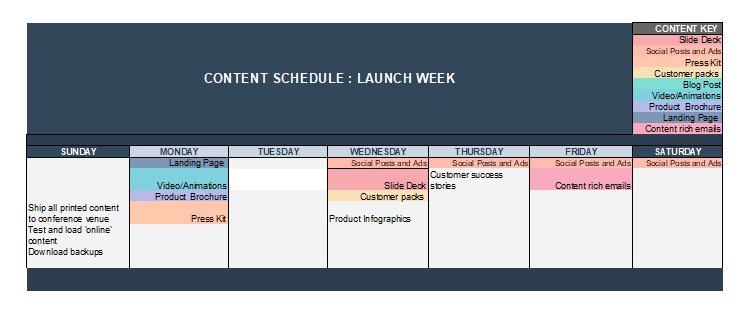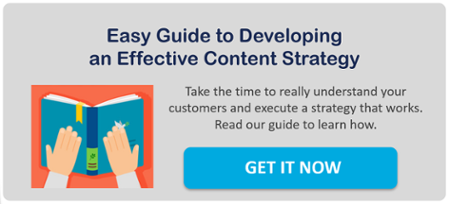
If content is king - then content scheduling is queen!
Creating marketing content takes time, financial investment and expertise. It requires an in-depth understanding of your customer, their buying habits and their interests to engage them in a relationship with your business. Great content has the power to increase sales, build new marketplaces, change behaviours, entertain, educate and excite.
But wait, it’s not enough to have a great content strategy without a content marketing plan that includes how you might schedule the delivery of the content across your online channels.
Scheduling is a collaborative effort - as a content creator you have a vested interest in ensuring content is shared across the appropriate communications channels.
Put another way, content creation and scheduling are ‘hand-in-glove.’
A refresh: what does good content look like?
Good content establishes a relationship with your target audience. It will always be relevant and helpful.
It will:
- Be attractive to your target audience
- Inform and educate your target group
- Engage them in an appropriate way
- Generate leads and sales
- Move your customers towards a lasting relationship
Developing campaign content can take weeks if not months to build. It can be costly if you get it wrong and often it is best to seek experts in this field who can help you determine strategy to support your internal efforts. No one will know your business better than you so make sure if you do outsource, partner with a business, like fileroom whose values are consistent with your own.
A useful approach is to look at what your competitors are doing – we are not advocating copying them as this doesn't work, but we all know knowledge is power and by getting a grasp on the competitive landscape it could be a springboard for some new ideas.
There are also several tools you can use to help monitor what content is trending with your target groups.
Put these in your back pocket
BuzzSumo tracks social shares and trending online and will also provide ideas for headlines that grab attention.
SemRush can help with backlinks, content ideas and keywords.
Feedly will keep you on track with popular topics in your industry and provide you with content ideas.
At other times content will grow from a specific event. Examples include, a product launch, branding refresh, sales and/or service seasonal offer. Or in this case of our current environment - the coronavirus.
Content will be geared specifically for the ‘event’ and might include an entire suite of materials to engage with the target audience delivered over a specific time period.
So, what does this look like?
Let’s call them Alpha Software: they will be launching a new upgrade to their small business software at their annual customer conference (which they have now transformed into a virtual conference). They need an integrated suite of marketing communications content that sticks, is adaptable, and speaks with ‘one’ voice across their target audience(s). Who are these audiences – they are their current customers, prospects, employees, shareholders, and the media.
The content must be ready to be ‘delivered’ over a one-week period.
It’s been months in the making, a huge investment for the small Alpha team, so the scheduling needs to be agreed across multiple channels and platforms. If they can get this right, they anticipate interesting the marketplace to make further purchases of their software solutions, support and training packages and engage them in word of mouth recommendations and testimonials. The ultimate business goal will be for Alpha Software to exceed their expectations and secure a multi-site agreement with an international player. The stakes have never been higher.
How could they approach this?
Yes, you have guessed it they need a rollout plan; a schedule if you like, that identifies each piece of content, its purpose and the delivery channel and timing for execution.
There are several companies like HubSpot, CoSchedule and Hootsuite who provide online scheduling tools and dashboards to automate this process for you. You can also download some free templates from these sites that can come in handy.
Using the free templates, you can easily draw up a schedule that aligns with your marketing planning tools. See below as an example.

The schedule is your roadmap to ensure ‘content’ isn’t lost and is leveraged by event and optimal timing. Audience engagement is the objective across traditional online channels, social media and face to face.
Additional columns or worksheets might be added to indicate the key message(s) for each piece of content and map desired outcomes against any key performance indicators.
A good planning document keeps you safe; its something you can share with the team members to get everyone on the same page and engage them in your marketing efforts. In the best organisations everyone recognises they have a role to play in delivering on marketing goals and sharing information keeps everyone on track.
Back to basics
The aim is having the suite of content that touches the hearts and minds of the people inside and outside your business. It needs to stand for something authentic, crafted with care and aligned to your business values.
The media you use, whether it be words and images on an online portal, an infographic on Instagram or video from YouTube, should speak with clarity about who you are and what you stand for when it comes to values and how you do business. You might not get a second chance.
But if you get it right, as many businesses do, you will stand tall in a competitive marketplace.
- Be knowledgeable and clear about the value of your product or service - this is a core principle for product marketing folks; they live and breath their products so don’t be afraid to dig a little deeper and unpack the technical knowledge they possess and apply it to your content development.
- Understand your customer’s preferences and how they want to interact with you - a principle of any customer relationship management platform; gather data about your customers communications preferences; do they use LinkedIn over Instagram, are they reading your e-news on a Sunday night. Get to know them.
- Deliver consistently high standards of customer care - Do you have a customer care hotline; how do your customers contact you if they have an issue; how do you train your staff to care about the customer?
It boils down to trust in the end. But as everyone knows trust has taking such a battering across the world lately. According to Edelman people base their trust on just two measures:
- Competence - this is defined as delivering on promises
- Ethical Behaviour - doing the right thing and trying to improve society
As a developer of content, you might wisely consider these two elements when developing the key messages and narratives you will be using in your content.
Ask yourself:
- Is the story truthful?
- Have I demonstrated proof points?
- What is the social, economic and environmental impact of the message I am conveying
It’s a people to people thing
Clever businesses understand it’s not enough to just have a business-to-business or business-to-consumer approach, it’s a ‘people to people’ thing. People are the buyers and the sellers. Consistent, intelligent marketing communications content, scheduling and placement can grow those relationships.
Remember, hand in glove!
Don’t forget people are also behind the content, graphic designing with colour and movement on the page, writers, shapers of sentences and paragraphs, then there’s the tellers of stories, the videographers, the copywriters, bloggers and not forgetting the editors and the proofreaders.
Not all businesses have large teams dedicated to fulfilling all the content requirements. You might be reading this and wearing many hats.
When it gets overwhelming, remember it’s ok to ask for a little help. We are in this together.
Learn more about developing an effective content strategy and download our guide below.





.png)






